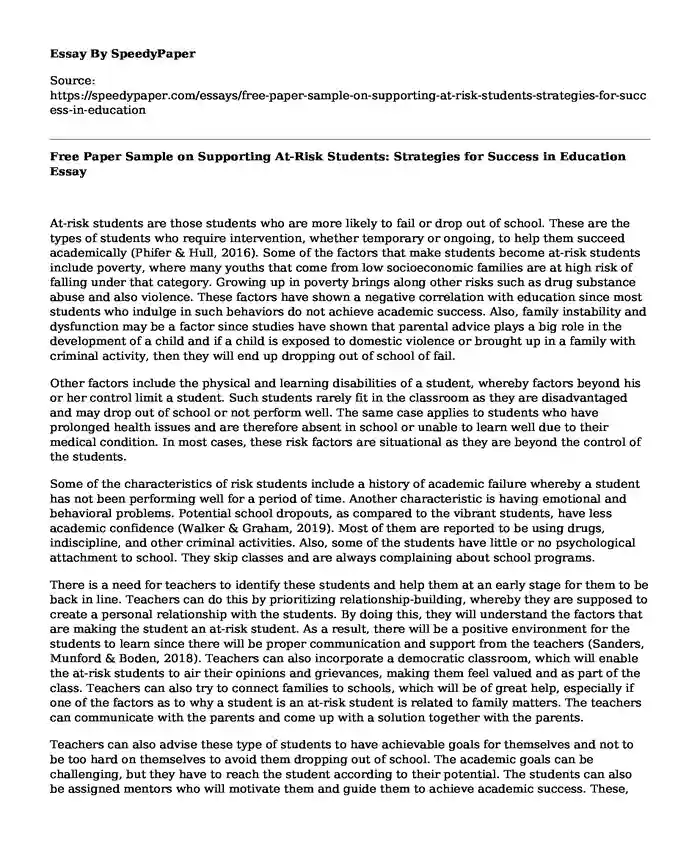At-risk students are those students who are more likely to fail or drop out of school. These are the types of students who require intervention, whether temporary or ongoing, to help them succeed academically (Phifer & Hull, 2016). Some of the factors that make students become at-risk students include poverty, where many youths that come from low socioeconomic families are at high risk of falling under that category. Growing up in poverty brings along other risks such as drug substance abuse and also violence. These factors have shown a negative correlation with education since most students who indulge in such behaviors do not achieve academic success. Also, family instability and dysfunction may be a factor since studies have shown that parental advice plays a big role in the development of a child and if a child is exposed to domestic violence or brought up in a family with criminal activity, then they will end up dropping out of school of fail.
Other factors include the physical and learning disabilities of a student, whereby factors beyond his or her control limit a student. Such students rarely fit in the classroom as they are disadvantaged and may drop out of school or not perform well. The same case applies to students who have prolonged health issues and are therefore absent in school or unable to learn well due to their medical condition. In most cases, these risk factors are situational as they are beyond the control of the students.
Some of the characteristics of risk students include a history of academic failure whereby a student has not been performing well for a period of time. Another characteristic is having emotional and behavioral problems. Potential school dropouts, as compared to the vibrant students, have less academic confidence (Walker & Graham, 2019). Most of them are reported to be using drugs, indiscipline, and other criminal activities. Also, some of the students have little or no psychological attachment to school. They skip classes and are always complaining about school programs.
There is a need for teachers to identify these students and help them at an early stage for them to be back in line. Teachers can do this by prioritizing relationship-building, whereby they are supposed to create a personal relationship with the students. By doing this, they will understand the factors that are making the student an at-risk student. As a result, there will be a positive environment for the students to learn since there will be proper communication and support from the teachers (Sanders, Munford & Boden, 2018). Teachers can also incorporate a democratic classroom, which will enable the at-risk students to air their opinions and grievances, making them feel valued and as part of the class. Teachers can also try to connect families to schools, which will be of great help, especially if one of the factors as to why a student is an at-risk student is related to family matters. The teachers can communicate with the parents and come up with a solution together with the parents.
Teachers can also advise these type of students to have achievable goals for themselves and not to be too hard on themselves to avoid them dropping out of school. The academic goals can be challenging, but they have to reach the student according to their potential. The students can also be assigned mentors who will motivate them and guide them to achieve academic success. These, among other ways, are methods teachers can undertake to ensure that they help at-risk students.
References
Phifer, L. W., & Hull, R. (2016). Helping students heal Observations of trauma-informed practices in the schools. School Mental Health, 8(1), 201-205.
Sanders, J., Munford, R., & Boden, J. (2018). Improving educational outcomes for atrisk students. British Educational Research Journal, 44(5), 763-780.https://doi.org/10.1002/berj.3462
Walker, S., & Graham, L. (2019). At-risk students and teacher-student relationships: student characteristics, attitudes to school, and classroom climate. International Journal of Inclusive Education, 1-18. https://doi.org/10.1080/13603116.2019.1588925
Cite this page
Free Paper Sample on Supporting At-Risk Students: Strategies for Success in Education. (2023, Oct 16). Retrieved from https://speedypaper.com/essays/free-paper-sample-on-supporting-at-risk-students-strategies-for-success-in-education
Request Removal
If you are the original author of this essay and no longer wish to have it published on the SpeedyPaper website, please click below to request its removal:
- Free Essay with a Personal Statement of an English Teacher
- Essay Sample: Playing World of Warcraft vs Content and Language Integrated Learning
- Free Essay on Faculty Use and Perceptions of a Course Management System
- Cosmopolitanism Essay Example
- Essay Sample with Learning Reflection on the Course of Interior Photography
- Paper Example - Sociological Imagination to Personal Trouble
- Free Essay Sample: Hurricanes and Tornadoes
Popular categories





